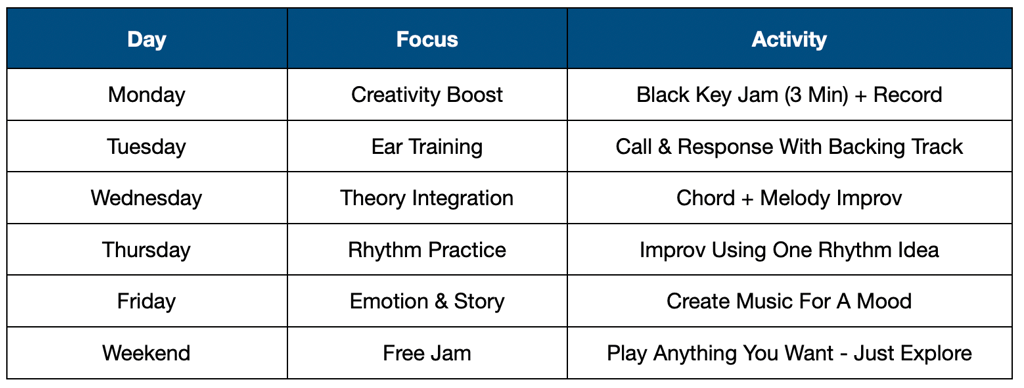Musical Improvisation Skills: Why It Matters & How to Get Started
Unlock your creative side at your instrument! Discover why improvisation is a game changer for pianists & keyboardists and how to start with simple, fun exercises that build real musical skills. From black key jams to storytelling with sound, this guide helps you explore, express, and grow as a confident, creative musician.
SKILL DEVELOPMENTMUSIC EDUCATIONLEARNING STRATEGIESMUSIC PRACTICE
Musical Improvisation Skills: Why It Matters & How to Get Started
If you’re a piano or keyboard student, you probably spend a lot of your practice time reading music, learning scales, and preparing pieces. But here’s something that often gets left out: musical improvisation - the art of making up music on the spot.
Improvisation isn’t just for jazz players or advanced musicians. In fact, it’s one of the most powerful ways to grow as a musician. It sharpens your creativity, strengthens your musical instincts, and makes everything you learn - from scales to chords - more meaningful.
In this blog, we’ll break down:
✅ What improvisation actually is
✅ Why it’s essential for piano/keyboard learning
✅ How to start, even if you’ve never improvised before
✅ Activities that help build real musical skills


🎼 What Is Improvisation?
Improvisation is spontaneous music-making. There’s no sheet music, no set plan - you’re using what you know to explore sounds and create in the moment. It might look like:
Playing a melody using a scale you’ve learned
Building chord progressions and jamming over them
Responding to a rhythm or musical prompt
Creating a musical “story” just for fun
Improvising trains you to think musically and express ideas fluently - just like speaking in your own words instead of reading from a script.
💡 Why Piano & Keyboard Students Should Improvise
Let’s connect improvisation with actual learning outcomes. Here's what it improves and how it works behind the scenes:
🎧 1. Aural Skills (Ear Training)
When you improvise, you constantly listen - to intervals, harmonies, and how notes connect. This trains your ear to recognise relationships like:
Major vs. minor
Consonance vs. dissonance
Step vs. skip vs. leap
Why it matters: Strong aural skills help you play by ear, transcribe music, and identify patterns in pieces quickly.
🧠 2. Theory in Action
Improvisation brings music theory to life. Instead of memorising scale names or chord types, you use them to make something.
Why it matters: When you apply scales and chords in a musical context, your brain understands them as expressive tools - not just data.
👐 3. Technical Control
When improvising, you repeat, vary, and explore - this naturally improves your finger coordination, fluidity, and control across different keys and rhythms.
Why it matters: You develop technique with more variety and flexibility, not just through set exercises.
🎭 4. Expression and Interpretation
Improvising teaches you to shape phrases, use dynamics, and make expressive choices without being told exactly how.
Why it matters: It builds emotional connection to music - something that can be hard to learn from sheet music alone.
🎹 How to Start Improvising
Improvisation is best learned like a language: start simple, practice daily, and don’t worry about mistakes. Here are a few student-friendly exercises designed to build musical skills step-by-step.
🎯 1. Black Key Improvisation
Why it works: The black keys form a pentatonic scale, which avoids clashing notes and always sounds good. It’s a safe zone for exploring.
🧩 Activity:
Use only black keys.
Set a slow pulse (e.g., left-hand tapping a low F# repeatedly).
Use your right hand to explore rhythms, short phrases, and patterns.
Add the sustain pedal for a lush sound.
Skill focus: Pattern recognition, phrasing, rhythmic variety, confidence building.
🎯 2. Scale-Limited Melody Creation
Why it works: Limiting note choices (e.g., C–D–E–G–A) helps focus creativity while reinforcing scale shapes and hand geography.
🧩 Activity:
Pick 5 notes from a scale (like C major).
Create a short melody with your right hand.
Try repeating it, then vary it slightly.
Add dynamics or articulation.
Skill focus: Motif development, melodic contour, phrasing.
🎯 3. Chord + Melody Improv
Why it works: Combines left-hand harmonic awareness with right-hand melodic creativity—just like how songs are built.
🧩 Activity:
Play I–IV–V–I chords (e.g., C–F–G–C) with your left hand.
Improvise a melody over those chords using the C major scale.
Try starting simple, then build complexity.
Skill focus: Harmony-melody coordination, chord-tone awareness, form.
🎯 4. Call and Response
Why it works: Builds phrasing skills and teaches you how to develop ideas.
🧩 Activity:
Play a 2-measure melody (“the question”).
Answer with a different 2-measure phrase (“the response”).
Try mirroring rhythms or ending on the same note.
Skill focus: Form, contrast and repetition, listening, musical dialogue.
🎯 5. Improv Storytelling
Why it works: Encourages emotional and expressive playing, as well as dynamic contrast and tempo variation.
🧩 Activity:
Pick a theme: a storm, a robot waking up, someone dancing.
Create a musical “scene” using tempo, rhythm, pitch, and dynamics.
Change the mood as your story progresses.
Skill focus: Expression, musical narrative, dynamic control.
Here’s how you can start building your improvisation muscle without getting overwhelmed.
🧠 Practice Plan: Weekly Improv Routine


Tip: Record 30 seconds each day. Re-listen at the end of the week to hear your growth!
Use a timer - Even 5 minutes of focused improv makes a difference.
Record yourself - It helps you reflect, improve, and capture great ideas.
Be kind to yourself - There’s no “wrong” in improvising - only ideas to explore.
Listen to others - Jazz, film scores, classical cadenzas - all are full of improvisation ideas.
🎁 Bonus Tips for Success
🚀 Final Thoughts
Improvisation isn’t just a fun extra - it’s one of the best ways to become a more musical pianist/keyboardist. It connects your ears, hands, mind, and heart. It helps you think like a composer, react like a performer, and feel like an artist.
So if you’ve been waiting for the “right time” to start, here’s your sign: "Now is Perfect". Open up your keyboard, pick a few notes, and let your music come alive.
Share this on:
About The Author


Padmavathy Divakaran is a distinguished pianist, arranger, and music educator, currently serving as the Director of Aum Piano Studio. Formerly the representative for MTB Exams in Tamil Nadu and Karnataka - a globally recognised music education board based in the UK - she has consistently championed excellence in music education. Padmavathy holds a BA (Honours) in Music from Middlesex University, London, and a Diploma in Higher Education – Music from KM College of Music and Technology, Chennai. Her outstanding talent has been recognised through multiple scholarships and awards, including those presented by Dr. A.R. Rahman. As a performer, she has showcased her versatility across classical and contemporary genres, playing with orchestras in both London and Chennai. She was a core member of the Roliwood Seaboard Ensemble, playing a key role in the global launch of the ROLI Seaboard. Her artistry has earned her the honour of performing at prestigious events, including a special performance for Prince William, Simon Cowell, and other notable personalities at The Founders Forum in the UK - a testament to her global reach and artistic impact.